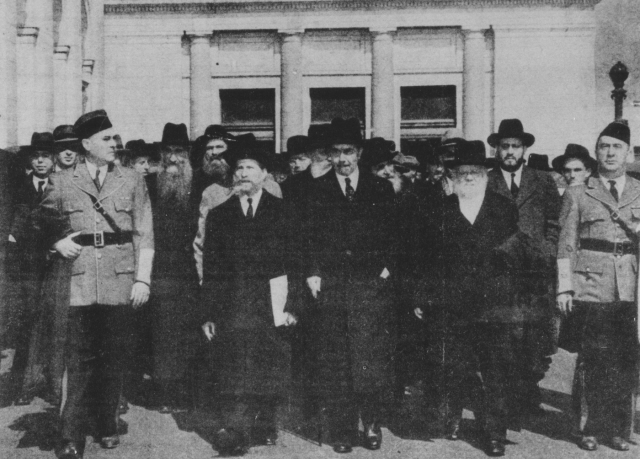70th Anniversary – The Bermuda Conference Begins
70 years ago today, delegates from the United States and Great Britain convened in Hamilton, Bermuda to discuss how to handle Jewish refugees who were still at risk for Nazi extermination in occupied areas, and how to handle those who had been liberated by Allied forces but had nowhere safe to go. The conference lasted for 12 days, and today remains a controversial event in WWII’s history.
The United States first learned of the Nazi plan to annihilate European Jewry as early as June 1942. In a report smuggled from Poland to London, it was revealed that the Nazis were using gas vans at Chelmno, one of six eventual death camps the Nazis would operate. It was estimated that 700,000 Jews had already been brought to Chelmno and gassed or shot to death. Official confirmation that Jews were being transported en masse to Auschwitz-Birkenau for forced labor and extermination first reached the Allies in November 1942, prompting a statement condemning “in the strongest possible terms this bestial policy of cold-blooded extermination.” The conference was called in direct response to these reports.
American Jewish leaders attempted to put together a committee to attend the conference, but their request was rejected. They instead sent along proposals on ways to rescue Jewish refugees. The conference attendees, headed by Harold Willis Dodds from the United States and Richard Law from the United Kingdom, ultimately rejected those proposals, and determined that although the Jewish population of Europe was in imminent danger, attention would be better spent on the total war effort in order to not divert Allied attention. Immigration quotas restricting the number of people from foreign countries that could enter the United States were to remain as is (it is worth noting that between 1933 and 1945, the United States allowed in only 132,000 Jewish refugees, which accounted for just 10% of the quota). Additionally, the UK ban that prevented Jewish refugees from obtaining asylum in British-controlled Palestine remained in place. Unknown to the public at the time, American delegates had arrived at the conference with explicit orders from the State Department to accomplish as little as possible, and did just that.
The American Jewish community responded to the conference with outspoken anger and frustration. Many Jewish Americans had family and friends trapped in Nazi-occupied territories. The American Zionist Committee for a Jewish Army ran an advertisement in the New York Times castigating the conference as a “cruel mockery” to the European Jews who were in danger, a move that prompted then-Senator Harry S. Truman to withdraw his membership from the Zionist group. Rabbi Eliezer Silver, leader of the Union of Orthodox Rabbis of the U.S. and Canada, organized a protest with over 400 fellow rabbis and marched through Washington to garner attention for the cause. Working with religious exemptions in immigration quotas, Rabbi Silver managed to rescue roughly 2,000 Jews from certain death.

Rabbi Eliezer Silver (front row, second from left) leads a march of Orthodox rabbis to the Capitol to bring attention to the plight of European Jewry. United States Holocaust Memorial Museum, courtesy of Lillian Silver.
It wasn’t until January 1944, at the urging of Secretary of Treasury Robert Morgenthau, that President Roosevelt acquiesced to the numerous protests and formed the War Refugee Board (WRB), which established refugee camps in North Africa, Italy, Palestine, Sweden and the United States. One of the WRB’s most notable contributions was financing the rescue work of Raoul Wallenberg, whose efforts saved thousands. By the end of the war, it is estimated that nearly 200,000 Jews were rescued through the WRB’s work. Though the WRB lobbied for President Roosevelt to publicly denounce the genocide taking place in Europe, he never did. The WRB was disbanded on September 15, 1945, after the war in Europe had come to an end.
Posted by Gemma Birnbaum, Digital Education Coordinator at The National WWII Museum.




Leave a Reply